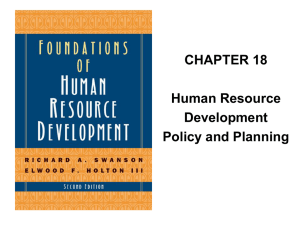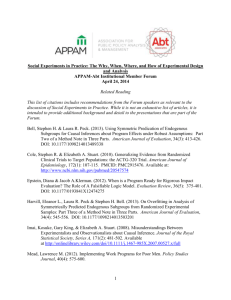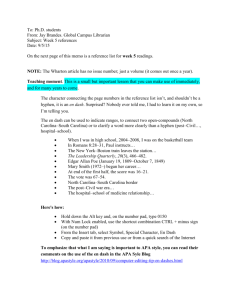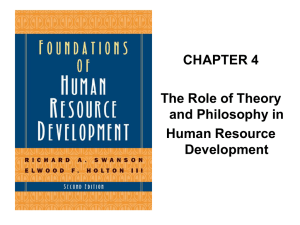Definition of Culture and Virtual Human Resource
advertisement
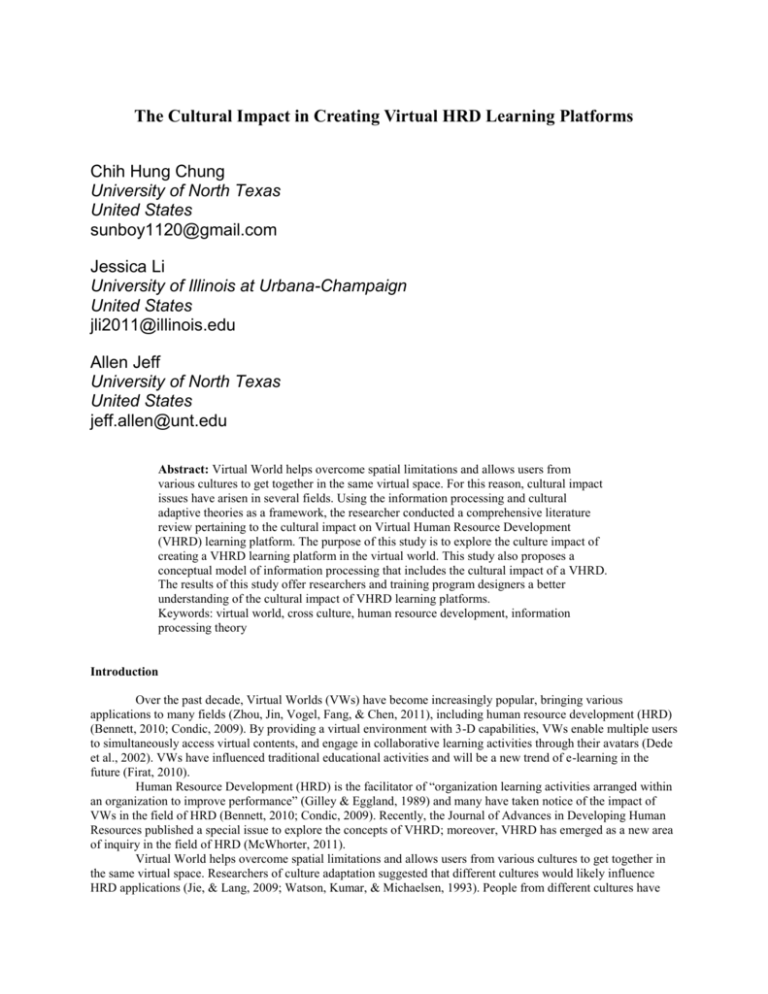
The Cultural Impact in Creating Virtual HRD Learning Platforms Chih Hung Chung University of North Texas United States sunboy1120@gmail.com Jessica Li University of Illinois at Urbana-Champaign United States jli2011@illinois.edu Allen Jeff University of North Texas United States jeff.allen@unt.edu Abstract: Virtual World helps overcome spatial limitations and allows users from various cultures to get together in the same virtual space. For this reason, cultural impact issues have arisen in several fields. Using the information processing and cultural adaptive theories as a framework, the researcher conducted a comprehensive literature review pertaining to the cultural impact on Virtual Human Resource Development (VHRD) learning platform. The purpose of this study is to explore the culture impact of creating a VHRD learning platform in the virtual world. This study also proposes a conceptual model of information processing that includes the cultural impact of a VHRD. The results of this study offer researchers and training program designers a better understanding of the cultural impact of VHRD learning platforms. Keywords: virtual world, cross culture, human resource development, information processing theory Introduction Over the past decade, Virtual Worlds (VWs) have become increasingly popular, bringing various applications to many fields (Zhou, Jin, Vogel, Fang, & Chen, 2011), including human resource development (HRD) (Bennett, 2010; Condic, 2009). By providing a virtual environment with 3-D capabilities, VWs enable multiple users to simultaneously access virtual contents, and engage in collaborative learning activities through their avatars (Dede et al., 2002). VWs have influenced traditional educational activities and will be a new trend of e-learning in the future (Firat, 2010). Human Resource Development (HRD) is the facilitator of “organization learning activities arranged within an organization to improve performance” (Gilley & Eggland, 1989) and many have taken notice of the impact of VWs in the field of HRD (Bennett, 2010; Condic, 2009). Recently, the Journal of Advances in Developing Human Resources published a special issue to explore the concepts of VHRD; moreover, VHRD has emerged as a new area of inquiry in the field of HRD (McWhorter, 2011). Virtual World helps overcome spatial limitations and allows users from various cultures to get together in the same virtual space. Researchers of culture adaptation suggested that different cultures would likely influence HRD applications (Jie, & Lang, 2009; Watson, Kumar, & Michaelsen, 1993). People from different cultures have various kinds of learning styles (Holtbrügge & Mohr, 2010; Nield, 2009; Olaniran, 2009). Hence, culture should be an important aspect to consider when designing VHRD learning platforms (Bennett, 2009). In this paper, we will explore the cultural impact of creating a HRD learning platform in VW and answer the following research questions: What are the cultural considerations when designing a VHRD learning platform; and how can a VHRD learning space help learners to overcome cultural barriers? A theoretical approach will be used by examining current literature pertaining to VWs, HRDs and crosscultural studies. The results of this study can provide researchers with a better understanding of the cultural impact of VHRD learning platforms. Implications of VHRD research and practice will also be discussed. Literature Review In this section, the literature related to virtual worlds, the cultural impact, and the definition of virtual world and culture will be discussed. Each topic will provide a relative literature review for developing an alternative model of the VHRD learning design and development. Definition of Culture and Virtual Human Resource Development The issue of culture has been broadly discussed in various fields, including sociology, linguistics, the medical field, economics, and humanities; therefore, the definition of culture is multifaceted. However, in the HRD field, Hofstede (1998) defined culture as follows: “Culture is the collective programming of the human mind that distinguishes the members of one human group from those of another. Culture in this sense is a system of collectively held values.” (p. 478). Hofstede’s (1998) definition of culture helps in understanding the basic conception of culture in HRD. Therefore, for this paper, Hofstede’s (1998) definition was adopted to study the impact of culture in VHRDs. Bennett (2009) stated the definition of VHRD as “a media-rich and culturally relevant web environment that strategically improves expertise, performance, innovation, and community building through formal and informal learning” (p. 364). For this paper, Bennett’s (2009) definition of VHRD was adopted to conduct the research about the cultural impact of VHRDs. The Development of Virtual Worlds (VWs) With the continuing development of Internet technology, Virtual Worlds (VW) has rapidly become an important issue in people’s lives (Zhang, Yu, Dang & Chen, 2010). An estimation by the Gartner Group, by the end of 2011, 80 percent of active Internet users will have the experience of using the virtual world platforms (“Gartner says 80 percent of active internet users…”, n.d.). The VW provides a diverse real-time social and economic interaction platform for users. The total number of residents in Second Life is 22,674,755 as of March 28, 2011 (“Second Life Grid Survey”, n.d.). Several educational and commercial interactive activities have been developed; for example, the Japanese automotive company, Toyota, built a virtual store in Second Life to show off their Scion xB model (Kaplan and Haenein, 2009). Moreover, many higher educational organizations have established Second Life University islands, such as the University of Texas at Dallas, University of North Texas, University of Florida, & University of Southern California, etc. In 2008, Google proposed its Google Lively products, a web-based virtual environment. However, in 2009, the service was closed. One of most important factors causing the closure was that Google’s VW was not as flexible as Second Life. In contrast, Second Life offers a flexible setting and allows its residents to hold the copyrights on anything created by them. In addition, Second Life allows residents to sell their contents (Kaplan & Haenein, 2009), and utilize more flexible functions. Currently, HRD in the VW has become an increasingly popular research topic (Bennett, 2011). However, few studies have focused on the important factors in the learning performance in VWs; especially, the cultural impact needs to be explored and discussed (Mockaitis, Rose, & Zettinig, 2012). Shachaf (2008) study showed that cultural diversity had a high impact on decision making, communication, and media select; thereby, this paper adopted a theoretical approach to explore and discuss the impact of cultural factors in VW. The Development of VHRD With the development of VWs, there has been an increased interest in the impact of VWs on the field of HRD (Bennett & Bierema, 2010). While all seem to agree that VWs play an important role in the field of HRD, opinions differ as to the present situation of VWs that have some restrictions that must be solved (Mancuso, Chlup, & McWhorter, 2010), such as technical problems and the lack of support for the equipment. Other researchers, however, advocate for the development of technology that could improve the effectiveness and efficiency of VWs, insisting that VHRD can promote the learning performance (Bennett, 2010; Graham, Muyia, & Nafukho, 2010). Therefore, McWhorter (2011) presented the concept that VHRD has emerged as a new area of inquiry in the field of HRD. In this paper, the cultural impact in the VHRD is discussed to improve the learning environment. The Cultural Impact on HRD The growth of globalization has prompted many people to study abroad to gain a wide range of experiences interacting with various people from different countries. The Internet also has the capacity to connect people from all over the world in the virtual world. Due to the popularity of 3D online games and social networks, more and more people are adapting to the virtual world environment (Bainbridge, 2010). International students and employees often face culture shock; however, the Internet has eliminated the distances between people which may help lessen culture shock by familiarizing users before travelling to other countries (De Lera, Fernandez, & Valverde, 2010). No matter where one is located, meetings with people from different countries can be held at any time (Dekker, Rutte, & Van den Berg, 2008). The Internet helps eliminate the feeling of distance between different counties, but it creates a problem, creating meaningful interactions between people because the Internet is not a reality environment which makes people feel like they are part of a machine instead of something more tangible. Therefore, many researchers and programmers have tried to design a friendly virtual world for users (Bruno & Muzzupappa, 2010). Although the interaction between societies in the virtual world has been proposed by several researchers, the impact of culture adaptation in the virtual world should be examined because the process of adapting to different cultures can help in designing more friendly interfaces and learning environments for users (McWhorter, 2011). Venkatesh, Thong, and Xu (2012) also asserted that culture differences were one of the most important factors influencing a user’s intention to utilize this technology. Culture shock might work to help certain people become more creative in overcoming the differences, but a big gap between different cultures might negatively impact personal learning performances (Bennett & Bierema, 2011). Many international students from different cultures come to the U.S. to study (Ku & Lohr, 2003). Generally, more time is needed for international students to adapt to a new culture; and this process of culture adaptation might negatively impact their learning performance. Therefore, understanding the culture adaptation process in the virtual world can help design a more environment that is friendly for diverse cultures learning performances. Cross-Cultural Adaptation Over the past few decades, cross-cultural adaptation has been discussed in a number of studies (Brettel & Spilker-Attig, 2010; Pflug, 2011). Kim (1988) defined cultural adaptation as, “the process of change over time that takes place within individuals who have completed their primary socialization process in one culture and then come into continuous, prolonged first-hand contact with a new and unfamiliar culture.” In addition, Kim (1988) proposed the cross-adaption theory as a cooperative joint effort between the unfamiliar and a receiving environment. Figure 1 presents details about the cross-cultural adaptation theory. This theory points to the environment and other major factors that influence people as they adapt to different cultures. Moreover, these procedures are cyclical and interact with other factors. Furthermore, when new events or changes occur, people or organizations will adapt to new situations by changing their behaviors, and this process is suitable for adapting to new cultures as well. The study conducted by Haslberger (2005) presented a new conception of the cross-adaptation theory that offered scales to consider, such as novelty, discretion, self-efficacy, and social networks, for the improvement of cross-cultural adaptation theory. These scales describe how cultural differences influence people’s behaviors in different cultural environments. However, he also indicated the cross-cultural adaptation process that people use to be able to function effectively in a different culture is complex. With this complex process, people try to change their behaviors to adapt to different cultures. Adaption Growth over time Stress A B Figure 1. A: Stress-Adaption-Growth Dynamic. Adapted from Kim, Y. Y. & Ruben, B.D. (1988). Intercultural transformation: A systems theory. In Y. Y. Kim & W. B. Gudykunst (Eds.), Theories in intercultural communication (pp.299-321). Newbury Park, CA: Sage. B: A communication model of the structure of cross-culture adaptation. Adapted from Kim, Y. Y. & Ruben, B.D. (1988). Intercultural transformation: A systems theory. In Y. Y. Kim & W. B. Gudykunst (Eds.), Theories in intercultural communication (pp.299-321). Newbury Park, CA: Sage. Information Processing Theory The information processing theory describes the process of environmental events that influence people to encode information to be learned, to memorize the knowledge, to store new knowledge in their long-term memory, and to obtain and apply the new knowledge (Ozcelik & Yildirim, 2005). Figure 2 shows a brief flowchart describing the information process theory in action. In the distance learning field, information processing theory has been broadly applied to interpret and describe trainees’ learning experiences and processes. Zhang and Zhang (2010) proposed a new information processing model for e-learning. This model included multimedia and cognitive tools in e-learning, and describes how to positively influence the information learning process. However, this model paid more attention to the Web 2.0 platform instead of the virtual world learning environment. Consequently, this paper adopted the information processing theory to develop a modified model to describe the learning behavior in the virtual world environment. Rehearsal Sensory Input Sensory Memory Attention Working (Short-Term Memory) Retrieval Encoding Long-Term Memory Figure 2. Information Processing Theory Output The Conceptual Model In the literature review, a conceptual model was proposed to explain the cultural impact in VHRD. Compared with the traditional models, our conceptual model increases the cultural impact and interaction between learners and instructor. Each learner and instructor has their own cultural way of thinking and physical capital. These cultural characteristics serve as a filter that influences a person how to understand and obtain information from others. Therefore, cultural characteristics can influence a person’s learning performance. Moreover, the process is very complex and needs to be understood and explored more fully so that we can improve the learning performance in the VHRD. The Interaction between Learners and Instructors The process of interaction between learners and instructors are continuingly changing. In this process, cultural characteristics would influence a learner in how to receive information and store the information as knowledge. This is because learners and instructors have their own cultural backgrounds. For this reason, the instructors utilize different teaching or training skills based on their own cultures. In this scenario, learners might obtain unreliable information due to misinterpretation brought on by different cultural-based teaching styles. In addition, the interaction between the learners also has a cultural impact in influencing the process of how a learner understands and accepts the shared information. According to the cultural adaptive theory, people’ cultural characteristics are constantly adapting to other different cultures. On the other hand, instructors are influenced by learners from different cultures. Moreover, the learners are also influenced by each other. Therefore, this process of interaction between instructor and learner is continually changing. Individual Information Processing In the individual information processing procedure, the cultural impact also plays an important role in influencing a person’s information processing. When a person receives information, the cultural impact could influence the result of sensor memory. However, through time, the cultural impact allows for information to be stored in the long-term memory. Finally, the storing process the cultural impact allows for influences the sensor memory again. The process is like a lifecycle; thus, this demonstrates that cultural impacts influence the information processing procedure. Rehearsal Sensory Input Sensory Memory Attention Working (Short-Term Memory) Retrieval Encoding Cultural Impact Output Long-Term Memory Learner Figure 4. The conceptual model of cultural impact in VHRD Instructor Discussion With the model presented by this study, we propose the consideration of cultural impacts in the VHRD. In this section, we discuss the characteristics of model, the distribution of information processing in VHRD, and the implications and limitations of the conceptual model. Characteristics of the Model Information in virtual world environment is presented in non-linearity and hypermedia forms. In the VHRD, individuals obtain information without many restrictions. Through interaction via the VHRD, people can deliver and gather information from others more quickly. Moreover, individuals gain needed and unnecessary mass information at the same time. However, this situation could result in positive or negative influences for people’s working or learning performances. For example, individuals could enjoy the flexibility of time in VHRD to obtain more information. In contrast, mass information causes individuals to spend more time filtering through needless information which decreases the performance of the information process. Regarding the cultural impact, the information space becomes more complex because the cultural impact influences how individuals obtain and understand the received information. The Distribution of Information Processing in VHRD The interaction between individuals is one of the most important factors in VHRD; in addition, it helps learning activities continually progress. The environment of VHRD increases the interactions between individuals and reduces the limitations of time and distance. The interactions eliminate the big gap in learning goals and spreads information widely and quickly. Compared to the face-to-face interactive approach, VHRD provides an effective and efficient learning process for learners. However, learners face a wide array of different cultures and need to adapt them quickly. The tools in VHRD also have different impacts on different cultures. Therefore, not only does the interaction between individuals have a cultural impact, but also the tools have cultural components as well. The cultural impact plays one of the critical key roles in influencing people’s learning performance in VHRD. Information Processing Construction and the Cultural Impact The VHRD environment allows the learner to continually exchange information with other individuals. Both internal and external information processing systems have a cycle of information distribution. With the information circulation, individuals accumulate cultural information and learning knowledge. Despite the fact that the cultural impact has some negative aspects at the beginning, the accumulation of cultural information and learning knowledge help individuals effectively and efficiently obtain valuable information in VHRD. Implications and Limitations of the Conceptual Model The study tried to utilize the conceptual model to explain the cultural impact in VHRD, and emphasized the information process along with the cultural impact in VHRD. In addition, the model points out the complexities of the interaction between internal and external information processing systems. The conceptual model adopts a systemic viewpoint to describe the cultural impact in the VHRD. For future studies, this conceptual model provides information processing along with the cultural impact. As a result, future research could explore how to improve people’s cultural adaptation to increase the learning performance in the VHRD. In addition, how to design and develop an effective VHRD that includes the cultural impact will be a research problem. Regarding the practical aspect; this model helps people understand the cultural impact process in the VHRD; therefore, training program designers can provide suitable training programs in the virtual world environment. The information process that includes the cultural impact in the VHRD in this conceptual model is still a hypothesis. This model needs to be tested in the future. Conclusion Cultural impact is one of the most important factors influencing learning performance. Particularly in the VHRD, the cultural impact in the information processing becomes more complex. This study provided a conceptual model to describe and discuss the cultural impact in the VHRD. After a review of the literature, the cultural impact issue in VHRD is still at the beginning stage. Based on the information processing theory and the cultural adaptation theory, the conceptual model of information processing that includes the cultural impact has been proposed by this study. Future work based on this study will continue to improve and test the conceptual model. References Bainbridge, W. S. (2010). Virtual worlds as cultural models. ACM Transactions on Intelligent Systems and Technology, 1(1), 1–21. doi:10.1145/1858948.1858951. Bell, M. W. (2008). Toward a definition of “virtual worlds”. Journal of Virtual Worlds Research, 1(1), 1-5. Bennett, E. E. (2009). Virtual HRD: The intersection of knowledge management, culture, and intranets. Advances in Developing Human Resources. 11(3), 362 – 374 Bennett, E. E. (2010). The coming paradigm shift: Synthesis and future directions for virtual HRD. Advances in Developing Human Resources. 12. 728-741. Bennett, E. E., & Bierema, L. L. (2010). The ecology of virtual human resource development. Advances in Developing Human Resources, 12(6), 632-647. doi:10.1177/1523422310394789 Bennett, E. E., & Bierema, L. L. (2011). The ecology of virtual human resource development. Advances in Developing Human Resources, 12(6), 632–647. doi:10.1177/1523422310394789 Bruno, F., & Muzzupappa, M. (2010). Product interface design: A participatory approach based on virtual reality. International Journal of Human-Computer Studies, 68(5), 254–269. doi:10.1016/j.ijhcs.2009.12.004 Brettel, M., & Spilker-Attig, A. (2010). Online advertising effectiveness: A cross-cultural comparison. Journal of Research in Interactive Marketing, 4(3), 176-196. doi:10.1108/17505931011070569 Condic, K. S. (2009). Using second life as a training tool in an academic library. Reference Librarian, 50(4), 333345. doi:10.1080/02763870903096419 Dede, C., Ketelhut, D. J., & Ruess, K. (2002). Motivation, usability, and learning outcomes in a prototype museumbased multi-user virtual environment. In P. Bell, R. Stevens, & T. Satwicz (Eds.), Keeping learning complex: The proceedings of the Fifth International Conference of the Learning Sciences. Mahwah, NJ: Erlbaum. Accessed August 6, 2009, available at, http://muve.gse.harvard.edu/rivercityproject/documents/AELppr.pdf. Dekker, D. M., Rutte, C. G., & Van den Berg, P. T. (2008). Cultural differences in the perception of critical interaction behaviors in global virtual teams. International Journal of Intercultural Relations, 32(5), 441–452. doi:10.1016/j.ijintrel.2008.06.003 De Lera, E., Fernandez, C. & Valverde, L. (2010). The emotional gap in virtual online environments. In Z. Abas et al. (Eds.), Proceedings of Global Learn Asia Pacific 2010, 67-70. AACE. Fırat, M. (2010). Learning in 3D virtual worlds and current situation in Turkey. Procedia - Social and Behavioral Sciences, 9, 249-254. doi: 10.1016/j.sbspro.2010.12.145 Gartner says 80 percent of active internet users will have a "Second Life" in the Virtual World by the end of 2011. (n.d.). Retrieved March 29, 2011, from http://www.gartner.com/it/page.jsp?id=503861 Gilley, J. W. & Eggland, S. A., (1989). Principles of human resource development, Addison-Wesley, NY. Graham, C. M., Muyia, H. M. A., & Nafukho, F. M. (2010). Harnessing and optimal utilization of human capital in virtual workplace environments. Advances in Developing Human Resources, 12(6), 648-664. doi:10.1177/1523422310394791 Haslberger, A. (2005). Facets and dimensions of cross-cultural adaptation: Refining the tools. Personnel Review, 34(1), 85-109. doi: 10.1108/00483480510571897 Hofstede, G. (1998). Attitudes, values and organizational culture: Disentangling the concepts. Organization Studies, 19(3), 477-493. doi:10.1177/017084069801900305 Holtbrügge, D., & Mohr, A. T. (2010). Cultural determinants of learning style preferences. Academy of Management Learning & Education, 9(4), 622-637. Jie, S., & Lang, B. (2009). Cross-cultural training and its impact on expatriate performance in Australian MNEs. Human Resource Development International, 12(4), 371-386. doi:10.1080/13678860903135763 Kaplan, A. M. & Haenlein, M. (2009). The fairyland of second life: Virtual social worlds and how to use them. Business Horizons, 52, 536-572. doi: 10.1016/j.bushor.2009.07.002 Kim, Y. Y. & Ruben, B.D. (1988). Intercultural transformation: A systems theory. In Y. Y. Kim & W. B. Gudykunst (Eds.), Theories in intercultural communication (pp.299-321). Newbury Park, CA: Sage Ku, H. Y. & Lohr, L. L. (2003). A case study of Chinese student’s attitudes toward their first online learning experience. Educational Technology Research and Development, 51(3), 95-102. doi: 10.1007/BF02504557 Mancuso, D. S., Chlup, D. T., & McWhorter, R. R. (2010). A study of adult learning in a virtual world. Advances in Developing Human Resources, 12(6), 681-699. doi:10.1177/1523422310395368 McWhorter, R. R. (2011). Exploring the emergence of virtual human resource development. Advances in Developing Human Resources, 12(6), 623–631. doi:10.1177/1523422310395367 Mockaitis, a. I., Rose, E. L., & Zettinig, P. (2012). The power of individual cultural values in global virtual teams. International Journal of Cross Cultural Management, 12(2), 193–210. doi:10.1177/1470595812439868 Nield, K. (2009). The problems of applying labels of learning style to national cultures. International Journal of Learning, 16(7), 425-434. Olaniran, B. A. (2009). Culture, learning styles, and web 2.0. Interactive Learning Environments, 17(4), 261-271. doi:10.1080/10494820903195124 Ozcelik, E. & Yildirim, S. (2005). Factors influencing the use of cognitive tools in web-based learning environments a case study. The Quarterly Review of Distance Education, 6(4), 295-308. Pflug, J. (2011). Contextuality and computer-mediated communication: A cross cultural comparison. Computers in Human Behavior, 27(1), 131-137. doi:10.1016/j.chb.2009.10.008 Second Life Grid Survey - Region Database. (n.d.). Retrieved March 29, 2011, from http://www.gridsurvey.com/ Shachaf, P. (2008). Cultural diversity and information and communication technology impacts on global virtual teams: An exploratory study. Information & Management, 45(2), 131–142. doi:10.1016/j.im.2007.12.003 Venkatesh, V., Thong, J. Y. L., & Xu, X. (2012). Consumer acceptance and use of information technology: Extending the unified theory of acceptance and use of technology. MIS Quarterly, 36(1), 157–178. Watson, W. E., Kumar, K., & Michaelsen, L. K. (1993). Cultural diversity's impact on interaction process and performance: Comparing homogeneous and diverse task groups. Academy of Management Journal, 36(3), 590-602. Zhang, Y., Yu, X., Dang, Y. & Chen, H. (2010). An integrated framework for avatar data collection from the virtual world. Intelligent Systems, IEEE, 25(6), 17-23. Zhang, J. H. & Zhang, J. P. (2010). An information processing model of e-learning from the ecological viewpoint. 2010 Second International Workshop on Education Technology and Computer Science. doi:10.1109/ETCS.2010.341. Zhou, Z., Jin, X. L.,Vogel, D. R. Fanf, Y. & Chen, X. (2011). Individual motivations and demographic differences in social virtual world users: An exploratory investigation in Second life. International Journal of Information Management. 31. 261-271. doi: 10.1016/j.ijinfomgt.2010.07.007



